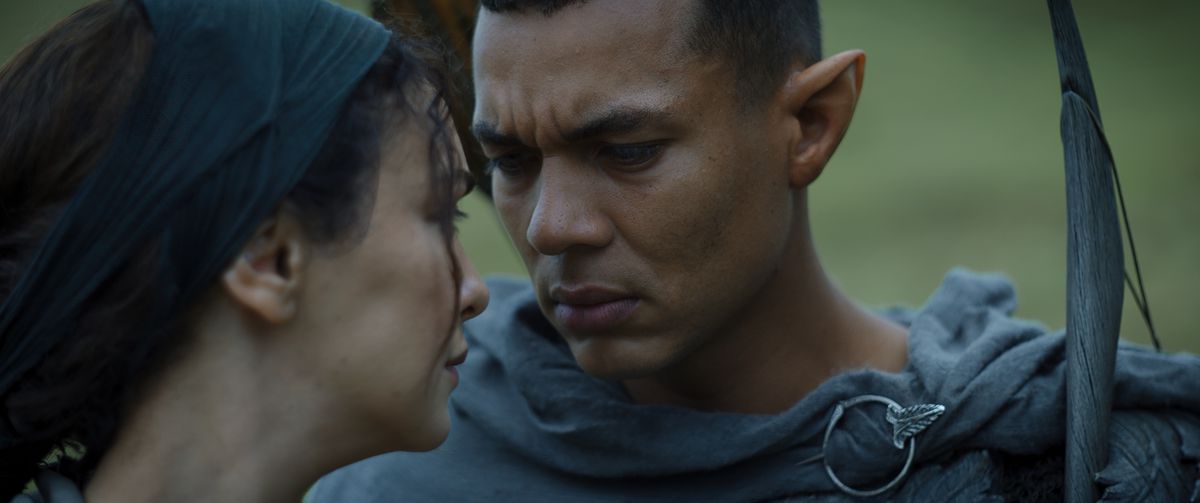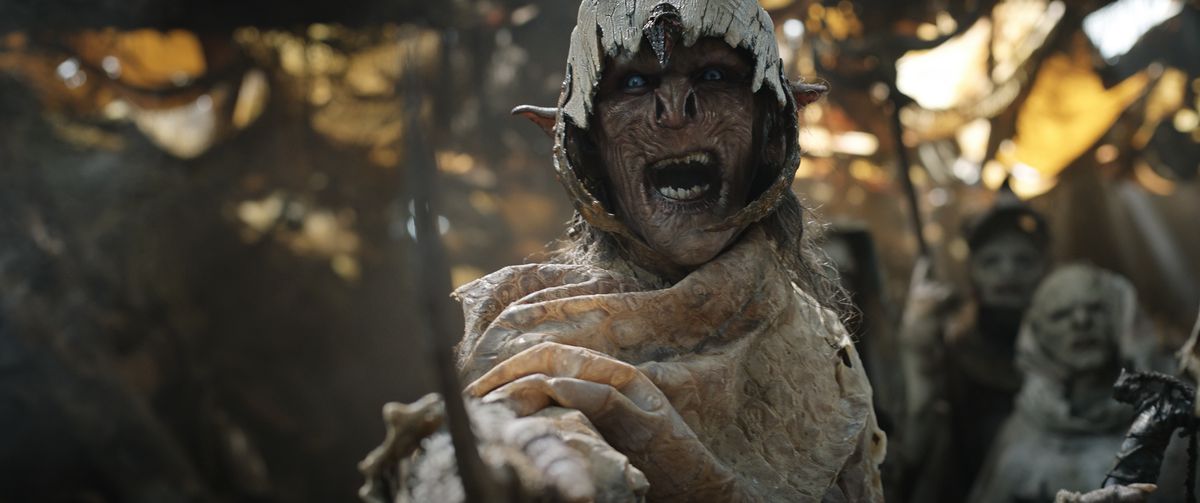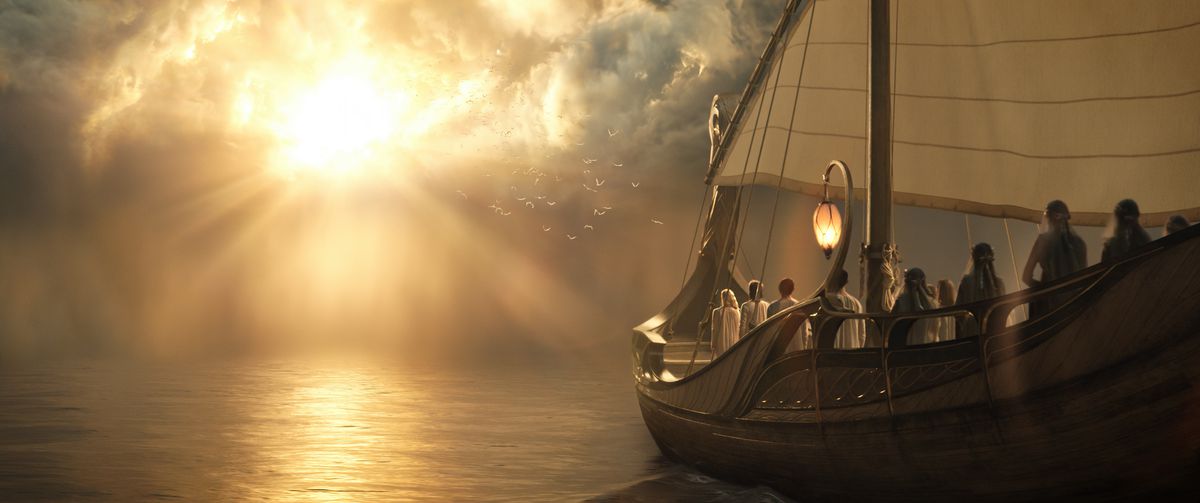Amazon’s The Lord of the Rings: The Rings of Power arrives on Prime Video this week burdened by outrageously high audience expectations. Not only does the streaming series have to live up to J.R.R. Tolkien’s beloved fantasy novels, but it also invites unavoidable comparisons to Peter Jackson’s The Lord of the Rings trilogy — collectively one of the most critically and commercially successful big-screen adaptations ever.
This can’t have made life easy for showrunners J.D. Payne and Patrick McKay. After all, how do you craft a Lord of the Rings show that paradoxically stays true to Tolkien (and, to a lesser extent, Jackson) while still breaking new ground? It’s a question The Lord of the Rings: The Rings of Power’s first two episodes aren’t really equipped to answer, since they ultimately come up short on both fronts.
That’s not to say that The Lord of the Rings: The Rings of Power doesn’t evoke Tolkien. Certainly, there are plenty of Tolkienesque plot beats littered throughout these first two episodes. Sinister, soul-corrupting McGuffins? Check. Forbidden interspecies love? Check. Hobbits swept up in world-changing events, the full significance of which fly well over their 3-foot-6-inch-high heads? Check. We’ve seen it all before, and frankly, seen it done better, too — especially the scenes involving the Harfoots — so why aren’t we diving into some other, unexplored corner of Middle-earth lore instead?
The same goes for Payne, McKay, and pilot director J.A. Bayona’s impressively cinematic vision of Middle-earth, which is clearly informed by the production design in Jackson’s films, itself inspired largely by legendary Tolkien artists John Howe and Alan Lee. Ditto the CGI, the fight choreography, bravura camera work, and (unsurprisingly) the main theme by The Lord of the Rings composer Howard Shore. It’s all terrific, but it’s all so familiar, too.
Image: Amazon Studios
Photo: Ben Rothstein/Amazon Studios
In fairness, there are moments when The Lord of the Rings: The Rings of Power expands on the established Middle-earth mythos to good effect. Scenes in the first episode that dramatize the oft referenced but never shown transcendent experience of passing into the West are infused with a lyrical quality that Tolkien himself would probably have appreciated. Similarly, the trip to Khazad-dûm in the second episode unearths several new facets of the delightfully bonkers dwarf culture, even solving the mystery of how dwarves get their daily dose of vitamin D.
It’s just a shame that the visual poetry and willingness to take risks in moments such as these aren’t more prevalent in The Lord of the Rings: The Rings of Power’s first two episodes. For the most part, Payne and McKay follow the Tolkien playbook to the letter, fashioning the story primarily from tried and true Middle-earth tropes such as solemn council sessions, moody dungeon crawling, and folksy pastoral hijinks. Admittedly, these are all ingredients the show was bound to include, if for no other reason than that fans are expecting to see them. But they’re so conceptually safe rather than daring, and executionally pedestrian rather than poetic, that it’s hard for us to get too excited.
And while we’re on the subject of poetry, that’s certainly not a word you’d use to describe the show’s dialogue. On the face of it, the portentous lines and evocative wordplay characters spout are very on brand for Middle-earth. There’s talk of an evil that doesn’t sleep and metaphors revolving around boats and stones searching for the light that are broadly reminiscent of Tolkien’s own writing. Yet these lines lack the author’s distinctive rhythms, which — for all they put meat back on the menu in The Two Towers — Jackson and screenwriters Philippa Boyens and Fran Walsh largely captured.
This particular shortcoming is one of the two biggest ways that The Lord of the Rings: The Rings of Power exposes how shallow its connection to Tolkien’s work can sometimes feel. Language was a big deal for Tolkien; he was an Oxford don who didn’t just study languages, he invented his own for fun. Heck, Middle-earth itself is built on made-up languages. So, the fact that so much of what’s said in The Rings of Power sounds clunky really undermines the show’s connection to the fictional world it’s so determined to be a part of.

Image: Amazon Studios

Image: Amazon Studios

Image: Amazon Studios
The other “tell” that The Lord of the Rings: The Rings of Power isn’t quite as keyed into Tolkien as it is modern TV are the various “mystery box”-style narrative devices. To be honest, these all feel alien to Middle-earth — especially the meteor man, and the Sauron sigil and sword. It’s not that Tolkien completely eschewed any form of mystery in his storytelling; as originally written, the Balrog’s arrival in The Fellowship of the Ring was all about clues and suspense. But he didn’t trade in dangling unanswered plot points, preferring instead to build his narratives around clearly defined goals like “kill dragon” or “destroy magic ring.”
That doesn’t mean Payne and McKay shouldn’t have introduced these plot threads in The Lord of the Rings: The Rings of Power. After all, they aren’t writing a book or even making a movie — they’re running a TV show. To do that well, they need to play to the strengths and weaknesses of the medium. If this demands that they occasionally go off book (literally), then so be it. But these narrative devices go beyond simply undercutting the overall Tolkien vibe of proceedings, hurting the pacing and focus of the show overall. There’s a lot going on in Middle-earth by the end of The Rings of Power episode 2, but the entertainment value of these story strands varies wildly.
The core “search for Sauron” strand is easily the most compelling of the bunch, and it lends The Rings of Power’s first episode plenty of narrative clarity and momentum. We know the Dark Lord is still out there, we get why Morfydd Clark’s Galadriel wants to take him down — we’re all in right from the jump. But as other subplots are added to the mix and the Sauron story takes a backseat, that clarity evaporates, and the momentum slows to a crawl. By the time Galadriel takes part in a Middle-earth re-creation of Jaws, where the show is going and when it plans on getting there have become as hard to decipher as the infamously crafty riddle above the gates of Moria.

Image: Amazon Studios
Of course, The Lord of the Rings is, at heart, a story about a journey, and The Rings of Power’s journey has only just begun. And the thing about journeys is that they often have a way of getting better after a rocky start — which may yet prove to be the case with this show. Yes, the first two episodes demonstrate some pretty major issues that the cast and crew need to address in season 1’s six remaining episodes. But there are signs that The Rings of Power could still evolve into the one Middle-earth adaptation to rule them all its showrunners clearly want it to be.
The board is clearly being set for the show’s titular magical bling to be forged, which (if the canon of the books is anything to go by) should put the main Sauron plot line front and center, where it belongs. It’s also hinted that a deep dive into Elven culture similar to what was done with the dwarves is on the cards — and most tantalizing of all, teases the prospect of exploring the idea of Elves as Middle-earth’s oppressors. Hopefully, this is emblematic of a greater willingness on Payne and McKay’s part to fill in the gaps left by Tolkien in even bolder ways the further into this first season we get. Bring on the weird and the strange!
And why not? As Celebrimbor observes in The Lord of the Rings: The Rings of Power’s second episode, true creation requires sacrifice — and surely that applies as much to adaptations weighed down by their own source material as anything else.

